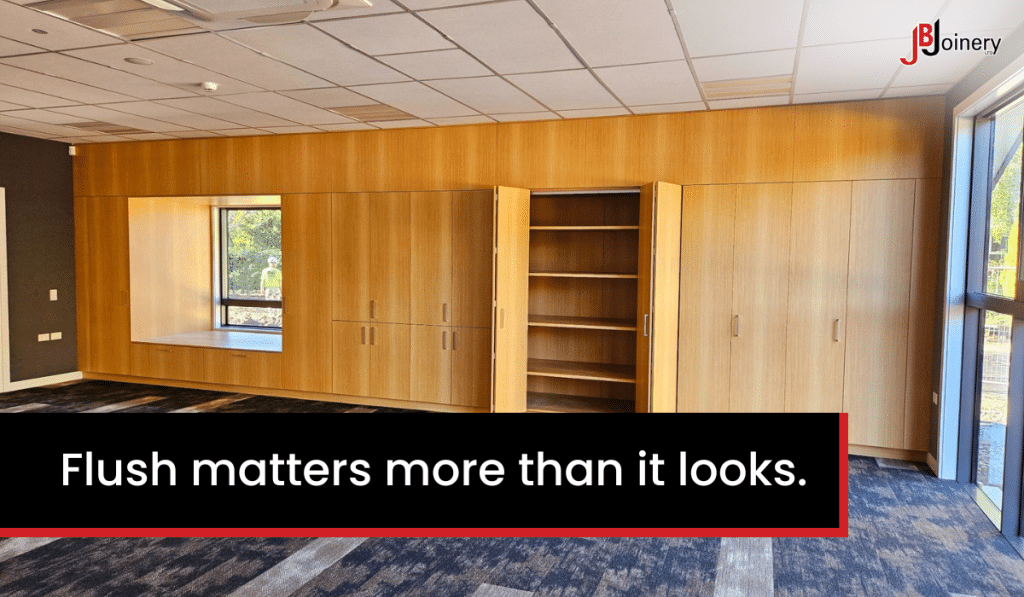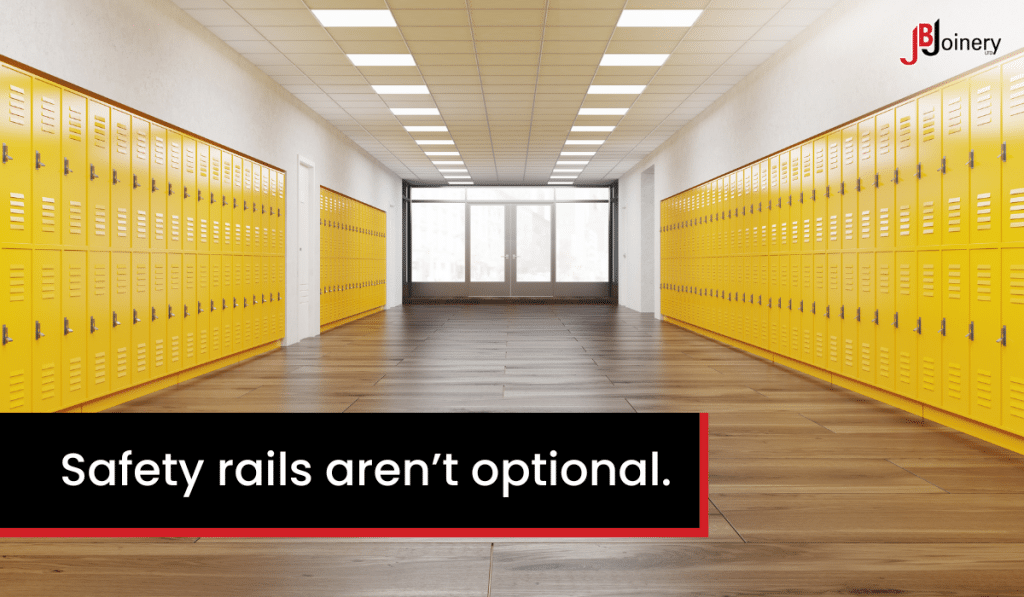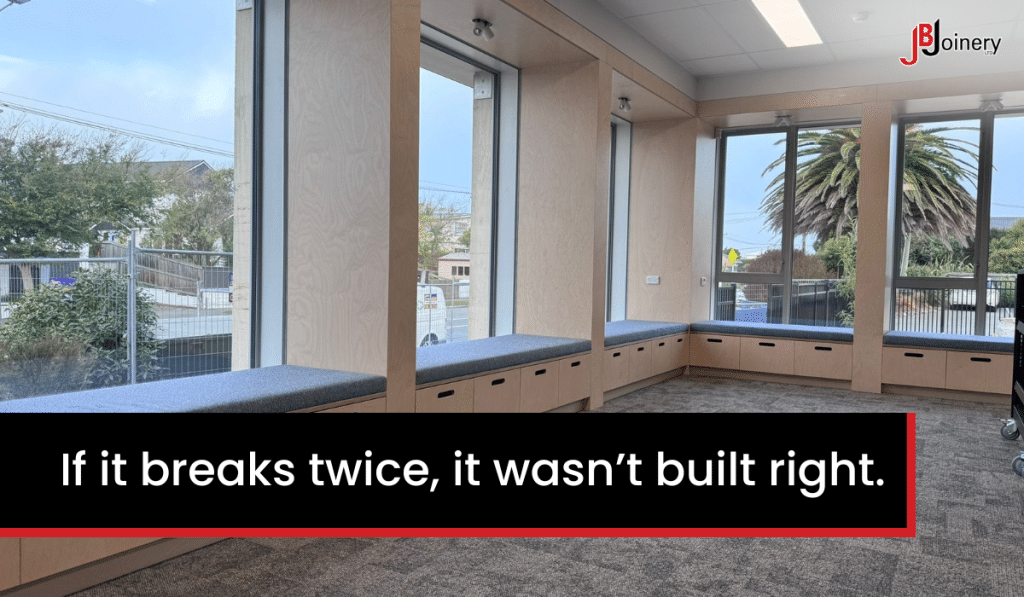In theory, every school fit-out looks promising on paper. The drawings show fresh lines, clean finishes, and spaces designed for a purpose. But once students arrive, the reality can shift—fast. Doors slam. Chairs drag. Bags swing. And before long, that “commercial-grade” joinery starts to show the strain of real student life.
A successful school fitout needs more than good design—it needs to be built for the daily pressure of young people moving, learning, and using every surface constantly. At JB Joinery, we know what fails in education settings because we’ve spent years designing what doesn’t.
If your school’s interiors are already showing wear, here are 15 signs the joinery wasn’t made with students in mind.
Doors shouldn’t become a sound effect in every lesson. When hinges groan and frames flex, the problem usually isn’t the students—it’s the joinery hardware. High-use doors in schools need hinges rated for repetition and materials that won’t warp after a few seasons. If the noise is interrupting lessons, the fitout didn’t account for real movement or use.

It starts subtly. A gap here. A misaligned hinge there. But over time, it becomes obvious. Cabinetry that never sits flush shows that the hardware wasn’t chosen with daily force in mind. Students don’t ease drawers shut—they pull and slam without thinking. If the edges don’t meet anymore, the materials or hardware weren’t ready for the pace.
Paint chipping, laminate peeling, edges dented within a single term? That’s more than natural wear. Joinery designed for education should last through thousands of hours of use. If the furniture or cabinetry looks tired after one or two terms, the fitout wasn’t aligned with how schools actually function.

Stairs, landings, and corridors need more than good lighting. They need fit-for-purpose handrails, balustrades, and solid fixings that support students of all ages and abilities. If you’re seeing slips or minor falls regularly—or worse, installing temporary fixes—it’s time to assess whether your joinery meets current education safety requirements.
Timber can be a beautiful, natural material. But in a school setting, it must be properly sealed and finished. Exposed timber that isn’t treated or protected begins to splinter under daily use. That means risk. If edges feel rough or shelves begin to flake, the finish wasn’t specified correctly or applied to withstand real-life touchpoints.
Open a cabinet and nothing fits. Books overhang, devices slip, and learning materials pile up awkwardly. That’s not a storage issue—that’s a planning issue. Storage should be dimensioned for actual education resources. If the layout makes sense only on paper but fails in practice, it wasn’t designed with classroom behaviour in mind.
If a table needs a laminated sign reminding students not to lean, the design missed the mark. Furniture in schools should work without instructions. That includes desks, lockers, benches, and shelving. If usage causes damage under typical behaviour, then the material or structure is wrong, not the students.
Facilities teams notice fitout flaws before anyone else. When surfaces are difficult to wipe down or joinery collects dust and grime in awkward crevices, it leads to frustration—and extra labour. Clean, sealed finishes and smart layout decisions reduce maintenance. If cleaning takes longer than expected, joinery choices are part of the problem.
From a distance, everything appears neat. But up close, you start spotting chipped corners, unfinished joins, and patch jobs that never matched the original spec. These are clear signs of low-quality finishes or quick fixes made under pressure. A school environment needs durable school furniture that holds up at close range, every day.
Every learning environment comes with specific requirements—from fire-retardant materials to height guidelines and safety clearance for built-in cabinetry. If the fitout looks like it came from a general office spec, it may not meet the education fitout compliance. Not every contractor understands these standards. At JB Joinery, we do—and we build to them from day one.

When the same cabinet breaks three times, or the same stair tread keeps lifting, it’s not a coincidence. Repeat issues show that the materials or installation were never aligned with actual school use. Schools are high-frequency environments. Repeated joinery failures are a symptom of poor planning and an even poorer understanding of long-term use.
Modern classrooms rely on devices—laptops, tablets, charging docks, and AV systems. Yet many fitouts ignore this reality. If power points are an afterthought or tech cables trail across walkways, your joinery wasn’t designed for current learning needs. School joinery design should include tech-ready cabinetry, safe cable paths, and secure charging zones.
Acoustics matter more than most people think. Echo in a classroom makes it harder for students to focus and harder for teachers to hold attention. Well-planned classroom cabinetry and timber panelling absorb sound without expensive additions. If your school feels loud all the time, your joinery may be contributing to the problem.
Fitouts that aren’t built for posture, visibility, and comfort lead to increased fidgeting. Desks are at the wrong height. Storage that’s hard to access. Surfaces that reflect glare. These small factors affect attention span. If teachers notice students shifting constantly, the solution may not be more rules—it might be smarter furniture built for learning.
You’ve run the numbers. You’ve weighed the cost of repairs. And you’re already thinking about replacement, even though the install was recent. That is the most telling sign. Good joinery hardware and layout planning should extend the life of a fitout—not shorten it. If you’re reaching this point early, it wasn’t built for schools.
A school fitout needs to do more than tick boxes on a drawing. It has to survive actual student use—day after day, year after year. At JB Joinery, we work with schools that are tired of quick fixes and generic furniture. Our team understands the demands of real classrooms, real stairwells, and real storage spaces.
From safety rails to seating zones, we build durable, low-maintenance, and smart joinery solutions that hold up to student behaviour and meet the standards education spaces demand.
If your current fitout is already showing signs it wasn’t made for the job, talk to us. We build what schools need to function—not just what looks tidy on install day.